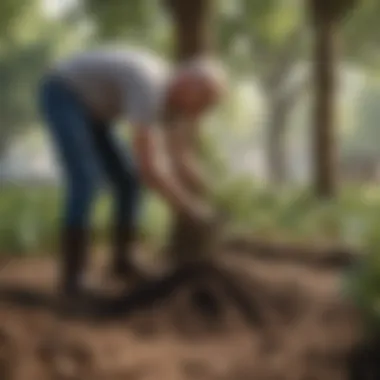We Grow Trees: Comprehensive Overview of Tree Cultivation


Intro
Trees are an essential component of our environment. They offer multifaceted benefits, from improving air quality to enhancing aesthetic appeal in urban landscapes. Understanding the significance of tree cultivation is crucial in fostering sustainable practices and supporting biodiversity. This article delves into various aspects of tree growth, focusing on methodologies, species selection, and the best practices that will nurture our trees effectively.
Key Insights and Trends
Exploring current trends in tree cultivation reveals a growing awareness of sustainability and environmental impact. Homeowners and gardening enthusiasts are increasingly opting for native species. Such plants often require less water and provide essential habitats for local wildlife. This shift is not just a trend; it represents a deeper understanding of the ecological balance we must aim to achieve.
In gardens, vertical planting and urban forestry projects have gained popularity. These techniques maximize limited space while optimizing resource use. By incorporating trees into urban areas, cities are recognizing their role in cooling environments and improving air quality. Many cities now maintain urban tree inventories to track species health and growth, fostering better decision-making about plantings and removals.
Practical Tips and How-To Guides
To successfully cultivate trees, thoughtful planning is necessary. Use the following practical tips as a guideline:
- Choosing the Right Species
Assess your local climate and soil type. Native species generally perform best because they evolve well in their environments. - Site Preparation
Clear the area of weeds and debris. Ensure good drainage can help trees establish strong root systems. - Planting Techniques
Dig a wide hole for the tree root ball. The depth should be equal to the root ball height. Backfill gently to avoid air pockets. - Maintenance
Watering during dry spells is essential. Mulching helps retain soil moisture, while regular inspections for pests ensure healthy growth.
"Planting and caring for trees requires commitment. The rewards, however, far outweigh the effort."
Following these guidelines, you can create a thriving environment for your trees.
In summary, trees are vital for our ecosystems. They play essential roles in enhancing human life and require attentive care and sustainable practices for optimal growth. This article aims to empower homeowners and gardening aficionados to cultivate these invaluable resources responsibly and effectively, thus contributing to a healthier planet.
Intro to Tree Cultivation
Tree cultivation is a practice that encompasses a range of techniques for growing trees in various environments. It is essential to understand the significance of trees and how their cultivation impacts ecological balance, economic structures, and aesthetic appeal in both urban and rural settings.
Growing trees offers numerous advantages. They provide shade, improve air quality, and enhance the beauty of landscapes. Additionally, trees contribute to biodiversity, create habitats for wildlife, and promote soil health. Understanding the methods of tree cultivation helps individuals, organizations, and communities make informed decisions about planting and caring for trees.
Successful tree cultivation requires knowledge about different species and their needs, as well as the best practices for nurturing their development. It also involves considerations regarding sustainable methods that ensure the longevity of tree populations. Trees not only contribute to the environment but also play a vital role in human life and health, establishing a deeper connection between people and nature.
Why Grow Trees?
Growing trees is essential for various reasons. They play a crucial role in combating climate change by absorbing carbon dioxide and producing oxygen. Trees act as natural air filters, trapping dust and pollutants, which significantly improves air quality. Moreover, they provide habitats for countless species, promoting biodiversity.
Some benefits of tree planting include:
- Reduction of heat in urban areas, which helps decrease energy costs.
- Soil stabilization, preventing erosion and maintaining water quality.
- Increase in property values due to improved landscapes.
- Psychological benefits, as exposure to greenery has shown to reduce stress levels.
The collective benefits of trees highlight the importance of integrating them into city planning and rural development.
Historical Significance of Trees
Throughout history, trees have held immense significance across cultures and civilizations. They have symbolized life, growth, and strength in many societies. Historically, trees provided food, shelter, and materials for construction and tools, reflecting their pivotal role in human survival and progress.
Various cultures have grounded their identities in the presence of trees. For instance, ancient civilizations revered trees as sacred beings, often using them for rituals and cultural practices. The felling of trees symbolized loss, emphasizing their deep-rooted importance.
In modern times, this historical reverence has evolved into a broader understanding of the ecological and economic contributions of trees. The lessons learned from past interactions with trees underscore the necessity to cultivate and protect them, ensuring their role continues in future generations.
"The planting of trees is a noble act that reflects our commitment to preserving the environment for the future."
Understanding Different Tree Species
Understanding the diversity of tree species is crucial for effective tree cultivation and management. Different tree species come with unique characteristics, adaptations, and ecological roles. This knowledge helps gardeners, homeowners, and environmentalists make informed decisions about which species to plant based on specific environmental conditions. The ability to choose appropriate tree species enhances the success of cultivation efforts and maximizes the ecological and aesthetic benefits they provide.
Deciduous vs. Coniferous Trees
Deciduous trees, such as oaks and maples, shed their leaves in autumn, preparing for winter dormancy. This seasonal change not only beautifies landscapes with vibrant fall colors but also helps the trees conserve water and energy during colder months. Coniferous trees, like pines and spruces, retain their needle-like leaves year-round, enabling them to photosynthesize even in winter conditions. This unique adaptation allows coniferous species to thrive in various climates, particularly in cooler regions. Both types of trees serve critical roles in ecosystems, offering habitats for wildlife and contributing to soil stability. Choosing between deciduous and coniferous trees depends on the desired benefits and local climate considerations.
Native Tree Species and Their Importance
Native tree species adapt well to local environments and support local wildlife populations. Their roots are established in the region’s soil, allowing them to thrive with less maintenance compared to non-native counterparts. These trees provide essential habitats and food sources for many species of animals and insects. For instance, the sugar maple is not only valued for its aesthetic appeal but also for its role in producing sap for maple syrup. When possible, planting native species contributes positively to biodiversity, strengthens ecosystems, and reduces the likelihood of introducing invasive species. Homeowners can enhance their gardens while fostering local ecosystems.
Exotic Tree Species: Benefits and Risks
Exotic tree species are non-native trees introduced into a new environment. They can provide significant benefits, such as ornamental beauty and quick growth, which may establish a rapid landscape transformation. Examples include the Leyland cypress and the Eastern redbud, both of which can enhance visual appeal quickly. However, there are risks associated with these species. If not managed properly, they can outcompete native species, disrupt local ecosystems, and may even introduce pests and diseases. Choosing exotic species requires a thorough understanding of their impact on the local environment. Homeowners should weigh the aesthetic appeal against potential ecological consequences.
"The choice of tree species can significantly influence the success of your landscaping projects and ecological health. Prioritizing native species often leads to a more balanced and thriving garden."
In summary, understanding different tree species is more than just knowledge. It's an essential element for fostering sustainable ecosystems and enriching our environments. By carefully selecting the right trees for planting, we can create landscapes that are both beautiful and ecologically responsible.
The Process of Growing Trees


The journey of tree cultivation is a critical yet intricate endeavor that demands careful attention to various steps. Understanding the process of growing trees is vital because it directly influences their health, growth rate, and longevity. Engaging in proper methods from seed selection to ongoing maintenance can lead to fruitful outcomes. Moreover, trees contribute enormously to environmental health and aesthetic beauty, making this process increasingly relevant to anyone interested in enhancing their outdoor spaces or reaping ecological benefits.
Seed Selection and Germination
Choosing the right seeds is the first and most important step in the cultivation process. Seed selection involves understanding the specific requirements for the species you wish to grow. Each species has unique soil, climate, and moisture preferences. For instance, oak seeds require well-drained soil and can handle a range of sunlight conditions, while cherry tree seeds thrive in loamy soils and need full sun.
Once you have selected the appropriate seeds, germination plays a crucial role. Seeds require the right conditions to sprout successfully. These include adequate moisture, proper temperature, and sometimes even a period of cold stratification for certain types. Generally, seeds should be placed in moist soil and kept in a warm area.
It is essential to ensure they are not overcrowded, as this will affect their access to nutrients and light. After a few weeks, you should see signs of sprouting. It is during this stage that patience is fundamental; not all seeds germinate at the same rate.
Transplanting Seedlings
Transplanting seedlings is a delicate but necessary phase in tree cultivation. Once seedlings reach a suitable size, they must be moved from their initial growing containers to their permanent locations. Timing is crucial here; typically, seedlings should be transplanted when they are about six to eight inches tall.
When transplanting, you should do so on cloudy days or in the late afternoon to reduce stress on the seedlings. Carefully remove the seedlings from their pots, ensuring you do not damage their roots. Prepare the planting site by loosening the soil and adding organic matter to improve drainage and nutrients. Place the seedling in the hole and gently pack the soil around it. Water the transplanted seedlings to help them establish.
"Transplanting is not just about relocating. It is about giving the tree a chance to thrive in its new environment."
Maintaining Healthy Growth
Proper maintenance is vital for the continued growth and health of trees. This involves a combination of watering, mulching, pest management, and monitoring growth. Newly transplanted trees need consistent watering until they establish roots in the new location. Mature trees, on the other hand, should only be watered during extended dry spells.
Mulching around the base of a tree helps retain moisture, control weeds, and provide nutrients as it decomposes. Choose organic mulch types, like wood chips or bark, for the best results.
Furthermore, keep an eye on any signs of pests or diseases. Early detection is key. Regularly inspect leaves and branches for discoloration or unusual growth patterns. If you notice any infestations, take action immediately to prevent further damage. Regular pruning can also encourage healthy growth by removing dead or crossing branches that may cause issues later. Maintaining healthy growth requires attention and effort but pays off significantly in the long run.
Environmental Benefits of Trees
Trees play a critical role in maintaining ecological balance and supporting life on Earth. Their multifaceted contributions to the environment are essential for both urban and rural settings. Understanding these benefits can help communities and individuals appreciate the value trees bring beyond mere aesthetics. In this section, we explore vital aspects such as air quality, carbon sequestration, and soil erosion prevention.
Trees and Air Quality
Trees serve as natural air purifiers. They absorb carbon dioxide and release oxygen through photosynthesis. This exchange is crucial for maintaining the balance of gases in the atmosphere. Additionally, trees filter pollutants such as sulfur dioxide, ammonia, and nitrogen oxides. They also trap airborne particles, including dust, pollen, and smoke. The presence of trees in urban areas improves air quality significantly, benefiting residents' health. Moreover, studies have shown that areas with abundant trees experience lower rates of respiratory issues and other related health problems.
"The more trees in an area, the cleaner the air for all inhabitants."
Carbon Sequestration
One of the most critical functions of trees is carbon sequestration. Trees absorb carbon dioxide from the atmosphere and store carbon in their biomass, including the trunk, branches, leaves, and roots. This process mitigates climate change by reducing the overall concentration of greenhouse gases. Young, rapidly growing trees sequester carbon at a higher rate, but all trees contribute over their lifetime. Forests act as significant carbon sinks, offering long-term solutions to combat global warming. Proper management and conservation efforts are necessary to enhance this benefit to maximize trees' capability to sequester carbon effectively.
Soil Erosion Prevention
Trees play a vital role in preventing soil erosion. Their root systems stabilize the soil, which reduces the risk of landslides and degradation. Tree canopies intercept rainfall, lowering the impact of water on the ground and preventing runoff. This helps maintain soil moisture, which is essential for agricultural practices. Furthermore, trees improve soil structure and promote biodiversity in the underground ecosystem. Healthy soil contributes to sustainable land use and cultivation, ensuring the availability of resources for future generations.
In summary, trees are not just a beautiful addition to our landscapes; they are fundamental to environmental health. Their air-purifying abilities, carbon absorption, and erosion control highlight their importance in effective ecosystem management and sustainability. Understanding these benefits is vital for homeowners, gardening enthusiasts, and anyone interested in preserving our planet.
Economic Impact of Trees
The economic impact of trees is significant and multifaceted. Trees contribute to both local and global economies through various channels, including the forestry sector, landscaping, and even tourism. Understanding this impact helps communities recognize the value of trees in their environments. This knowledge can drive policies and practices that support tree planting and maintenance.
Forestry and Timber Industry
The forestry and timber industry is one of the most direct economic benefits derived from trees. It includes the harvesting, processing, and marketing of timber products. In many regions, forestry provides jobs and supports local economies.
- Job Creation: The timber industry creates various jobs, ranging from logging and transportation to processing and retail. Many small communities rely on these jobs for their livelihoods.
- Revenue Generation: Timber sales contribute significantly to local and national economies. Businesses depend on a continuous supply of quality timber for construction, furniture, and paper products.
- Sustainable Practices: Sustainable forestry practices ensure that tree harvesting does not lead to deforestation. Certification programs like those offered by the Forest Stewardship Council advocate for responsible management of forest resources. This approach can enhance the marketability of timber products.
In summary, the forestry and timber industry is essential not only for economic development but also for promoting sustainable resource management, creating both jobs and sustainable practices.
Value of Landscaping Trees
Landscaping trees enhance property values and contribute to the aesthetics of communities. A well-designed landscape with mature trees can positively influence the growth of real estate values.
- Property Value Increase: Homes surrounded by trees often command higher prices and sell faster than those without. Studies show that mature trees can increase property values by 10-20%.
- Energy Savings: Strategically planted trees reduce heating and cooling costs by providing shade in summer and wind protection in winter. This cost-saving benefit can encourage homeowners to invest in tree planting.
- Community Appeal: Landscaped areas with trees create inviting spaces for residents and visitors. Urban areas with trees have been shown to attract tourists, which can boost local businesses.
"Investing in trees is investing in the future of our communities."
Understanding the economic impact of trees is crucial for both policy-makers and individuals. As such, it promotes a greater appreciation for trees and can guide effective decision-making in communities.
Aesthetic and Psychological Aspects
The intersection of aesthetics and psychology in tree cultivation is a vital topic. Trees not only enhance the landscape but also influence the psychological well-being of individuals. The mere sight of trees contributes to a more appealing environment, which can transform urban areas into green sanctuaries.
Urban Greening and Landscape Design


Urban greening refers to the practice of increasing vegetation in urban settings. Landscape design incorporates trees, shrubs, and other plants. Together, they create inviting public spaces and personal gardens. Trees serve multiple roles in these settings. They provide shade, reduce heat, and create a habitat for wildlife. Moreover, trees can delineate spaces and enhance the design of outdoor areas.
A few benefits of urban greening include:
- Improving air quality.
- Reducing noise pollution.
- Mitigating urban heat island effect.
Effective landscape design requires careful consideration of tree species and their arrangement. Native tree species are often favored due to their adaptability and wildlife support. A thoughtful design not only beautifies a place but also fosters community interaction. Greenspaces encourage activities such as walking, lounging, or enjoying nature, which improve social ties.
Impact of Trees on Mental Well-being
Trees provide more than visual appeal; they greatly influence mental health. Research consistently shows that natural environments contribute positively to psychological health. Spending time in greenspaces lowers stress levels and promotes emotional resilience. Trees invite relaxation and contemplation, often acting as a buffer against urban life's frenetic pace.
The presence of trees can lead to greater community satisfaction. Well-maintained urban forests can create a sense of belonging among residents. In fact, studies suggest that trees can enhance moods and increase feelings of happiness.
"Natural environments have significant benefits for mental health, reducing anxiety and depression while promoting well-being."
Incorporating trees into everyday life can be done in various ways. Homeowners can plant trees in their gardens. Communities can organize tree planting events. Schools may create nature-based curricula emphasizing the value of trees. Each of these actions contributes positively to individual and collective mental health.
In summary, trees play a critical role in both aesthetic and psychological contexts. They elevate landscapes, enhance community interactions, and promote mental well-being, making them indispensable assets in urban and rural environments.
Sustainable Practices in Tree Growing
Sustainable practices in tree growing are crucial, aiming to enhance biodiversity, improve soil health, and contribute to the overall ecosystem health. Implementing these practices not only ensures that future generations can enjoy trees, but it also promotes resilience against climate change effects. As we explore sustainable methods, we’ll look at various strategies that support not only the trees themselves but the surrounding environmental context as well.
Adopting sustainable practices can provide numerous benefits, such as:
- Enhanced biodiversity: Cultivating a variety of tree species encourages a richer ecosystem by supporting various animal and plant life.
- Soil improvement: Healthy tree systems help prevent erosion and maintain soil nutrients, which is vital for future plant growth.
- Water management: Trees play a key role in managing water cycles, helping to reduce runoff and promote groundwater recharge.
In the following sections, we will delve into specific approaches like permaculture, agroforestry, and companion planting. Each of these techniques represents a thoughtful way to integrate tree cultivation with ecological principles.
Permaculture and Agroforestry
Permaculture integrates agriculture with sustainable practices to create resilient and self-sustaining ecosystems. In a permaculture system, trees are not - just solitary entities but are part of a larger design that emphasizes relationships among plants, animals, and microorganisms. This results in enhanced productivity and reduced expenditure on resources.
Agroforestry, a related concept, combines trees with crops or livestock, creating a multifunctional land-use system. This approach promotes better yields while improving soil health and counteracting pests naturally.
Key aspects of permaculture and agroforestry include:
- Diverse planting: Different species can support each other, creating a balanced ecosystem.
- Integrated pest management: Trees can attract beneficial insects that help manage pests while offering shelter.
- Resource efficiency: Trees can utilize water and nutrients differently than crops, minimizing competition and maximizing resource use.
By employing these methods, one can truly enhance the ecosystem while contributing to sustainable agriculture.
Companion Planting
Companion planting refers to the strategy of growing different plants together to leverage their beneficial relationships. This technique is particularly valuable for tree cultivation, as it can enhance growth and reduce pests naturally.
For instance, certain plants can repel harmful insects that dine on young trees, while others may provide nutrients or support for tree growth. Companion planting can include:
- Nitrogen fixers: Plants such as clover can improve soil fertility, benefiting nearby trees.
- Pest deterrents: Marigolds are known for repelling nematodes and other pests, protecting tree roots.
- Support structures: Some plants can provide physical support for climbing plants, which may enhance the overall system's resilience.
Implementing companion planting in tree growing practices establishes a more balanced ecosystem, optimizing both tree health and agricultural productivity.
Adopting sustainable practices enhances our planet while securing the vital roles trees play in urban and rural environments.
Challenges in Tree Cultivation
Tree cultivation offers numerous benefits, yet it also presents challenges that must be acknowledged. Understanding these challenges is crucial for successful tree growth and management. Homeowners, gardening enthusiasts, and those interested in sustainable practices must be mindful of these obstacles to achieve their goals in tree cultivation.
Pests and Diseases
Pests and diseases are significant threats to tree health. Common pests such as aphids, borers, and caterpillars can severely damage trees. These pests feed on leaves, stems, and roots, leading to weakened plants. Vegetation becomes more vulnerable to diseases if trees are compromised.
Diseases like root rot, blight, and rust can also spread quickly within and between trees. Take preventive actions to keep trees healthy. Regular monitoring is essential.
Consider implementing integrated pest management techniques. These may include biological controls, such as introducing natural predators, and cultural practices like proper watering and pruning. Using resistant tree species also contributes to lowering risks.
Climate Change Effects
Climate change influences tree growth in various ways. Rising temperatures, altered precipitation patterns, and extreme weather events can affect tree health. Some tree species struggle to adapt, while others may thrive under changing conditions.
Trees may experience shifted growing seasons, which can impact flowering, fruiting, and seed dispersal. Some species face increased vulnerability to pests and diseases driven by climate changes.
To mitigate these effects, it is essential to select tree species that are resilient to climate variations. Homeowners can engage in local reforestation efforts, which support the adaptation of ecosystems. This enables trees to better cope with challenges posed by a changing climate.


"Adaptation and resilience are key when nurturing trees in an ever-changing world."
Tree Protection and Conservation
Tree protection and conservation are critical to sustaining our environment. With increasing urbanization, deforestation, and climate change, trees face numerous threats. Therefore, it is essential to understand the significance of protecting these invaluable resources. They serve multiple purposes, from improving air quality to providing habitat for countless species. The effective conservation of trees not only contributes to ecological balance but also enhances our quality of life.
In many regions, governance and community engagement play key roles in tree preservation. Legal frameworks help establish guidelines for tree protection. Without these regulations, trees could face indiscriminate removal, leading to negative ecological impacts.
Tree conservation is not solely about legal measures. Community involvement can bolster protection efforts. Engaging local citizens empowers them to take part in the sustainable maintenance of trees. This results in active participation, raising awareness about the significance of trees and fostering a sense of shared responsibility.
Legal Frameworks for Tree Protection
Legal frameworks are vital for the protection of trees. These laws can provide a structured approach to safeguarding trees from harm and ensuring their longevity. Many countries have established tree protection ordinances that regulate how trees can be removed or pruned. Such laws often require permits, making it harder for individuals or companies to clear forests without justification.
These frameworks can include:
- Tree Preservation Orders (TPOs), which protect specific trees or groups of trees.
- Environmental Impact Assessments (EIAs), which analyze the potential effects of development projects on local flora and fauna.
- Local ordinances that restrict tree removal to protect public green spaces.
It is important for communities to be educated about these laws. Understanding local regulations can empower residents to report violations and advocate for better tree management.
Community Involvement in Conservation Efforts
Community involvement is crucial in promoting tree protection and conservation. Local citizens can become powerful advocates for trees in their neighborhoods. Through various initiatives, communities can organize tree-planting events, educational workshops, and awareness campaigns.
Some tangible ways the community can engage include:
- Organizing tree planting days to enhance local green spaces.
- Participating in clean-up drives to maintain existing areas with trees, ensuring they thrive.
- Collaborating with local government to address issues of deforestation or habitat loss.
"Local actions can lead to significant environmental impact. Every tree planted can contribute towards a more sustainable future."
Such efforts not only foster a sense of community but also help instill values of stewardship in individuals. A collective approach makes tree conservation a shared responsibility, reinforcing the idea that healthy trees are beneficial for all.
In summary, tree protection and conservation require both strong legal frameworks and active community participation. By establishing regulations and promoting public involvement, we can ensure trees continue to thrive in our urban landscapes and rural areas alike.
The Role of Technology in Tree Cultivation
Technology has become a pivotal element in the realm of tree cultivation. As modern challenges such as climate change, urbanization, and biodiversity loss persist, the integration of innovative technologies into tree management becomes more crucial. Effective use of technology allows for better monitoring, growth optimization, and resource management. Through the use of drones, sensors, and smart irrigation systems, both commercial growers and hobbyist gardeners can enhance their practices and promote healthier growth.
Use of Drones in Tree Monitoring
Drones play a significant role in the contemporary monitoring of tree health and growth. They provide aerial views that allow for the assessment of forest conditions, canopy structure, and even tree species identification. With the ability to cover large areas quickly, drones facilitate the detection of issues like pest infestations, diseases, or any signs of distress in trees.
The precision of drone technology is beneficial for:
- High-resolution imagery: Drones capture detailed images that inform about tree health and growth patterns.
- Automated data collection: Data can be collected through preset flight paths, providing accurate and repeatable results.
- Cost-effectiveness: Using drones reduces the manpower and time required for traditional monitoring methods.
With these benefits, tree growers can make more informed decisions, ensuring the longevity and vitality of their trees while also optimizing resources.
Innovative Irrigation Techniques
Water management is critical in tree cultivation; innovative irrigation techniques make this task more efficient and sustainable. Traditional irrigation practices often lead to water wastage and can weaken the ecosystem balance. Technologies such as drip irrigation and smart water management systems provide solutions that promote both conservation and healthy growth.
- Drip Irrigation: This method delivers water directly to the base of each tree, minimizing evaporation and runoff. It allows for precise control over water application, ensuring trees receive the necessary moisture without excess.
- Soil Moisture Sensors: These devices monitor the moisture levels in the soil in real-time, enabling growers to make data-driven decisions about when to irrigate. This capability reduces water waste and supports healthier soil biology.
Incorporating these irrigation techniques supports sustainable tree growing while enhancing the overall efficiency of water use. With dwindling resources due to climate changes, such technology is vital for securing tree health in various environments.
"The role of technology in tree cultivation cannot be overstated; it opens up new avenues for sustainability and efficiency."
For further reading about tree cultivation technology, visit wikipedia.com and britannica.com.
By embracing these methods, homeowners and gardening enthusiasts can significantly improve their cultivation practices while contributing positively to our environment.
Future of Tree Growth and Sustainability
The future of tree growth and sustainability is an essential theme in understanding the broader implications of tree cultivation. Trees play a significant role in mitigating climate change, enhancing biodiversity, and sustaining ecosystems. As urban populations grow, the demand for green spaces increases. This leads us to emphasize the importance of integrating trees into urban planning and designing for sustainable growth.
Trends in Urban Forestry
Urban forestry is rapidly evolving as cities recognize the need for greenery amidst urbanization. Current trends focus on implementing green infrastructure. This includes the integration of trees into streetscapes, parks, and rooftops to enhance urban environments.
- Green Roofs: They are gaining popularity. These living roofs not only provide insulation but also improve air quality.
- Tree Canopy Coverage: Cities aim to increase their overall tree canopy coverage. Many municipalities have set ambitious goals to reach certain canopy levels.
- Community Engagement: Involving local communities in tree selection and planting ensures that urban forestry plans are supported and maintained.
Emerging technologies also enhance urban forestry efforts. Geographic Information Systems (GIS) help in mapping tree distributions. Drones can assess the health of urban forests efficiently. Such technologies foster better planning and management practices.
Individual Contribution to Tree Planting
While cities play a crucial role in tree growth, individual contributions remain invaluable. Public participation in tree planting initiatives is essential for fostering an environmentally conscious society.
- Personal Initiatives: Homeowners can plant trees in their yards or support local tree nurseries. Even small actions contribute significantly to tree population growth.
- Educational Programs: Participating in or organizing programs about tree planting can raise awareness about environmental stewardship.
- Social Media Campaigns: Online platforms can raise attention and motivate others to engage in sustainable practices. For example, sharing personal tree planting experiences on Facebook or Reddit creates a ripple effect.
- Local Partnerships: Collaborating with community organizations for tree planting events fosters a collective sense of responsibility towards the environment.



